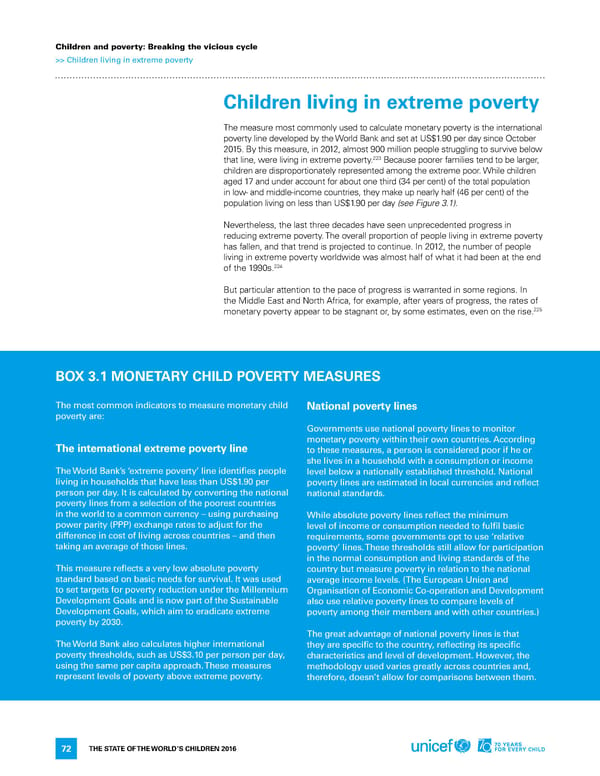Children and poverty: Breaking the vicious cycle >> Children living in extreme poverty Children living in extreme poverty The measure most commonly used to calculate monetary poverty is the international poverty line developed by the World Bank and set at US$1.90 per day since october 2015. By this measure, in 2012, almost 900 million people struggling to survive below 223 that line, were living in extreme poverty. Because poorer families tend to be larger, children are disproportionately represented among the extreme poor. While children aged 17 and under account for about one third (34 per cent) of the total population in low- and middle-income countries, they make up nearly half (46 per cent) of the population living on less than US$1.90 per day (see Figure 3.1). nevertheless, the last three decades have seen unprecedented progress in reducing extreme poverty. The overall proportion of people living in extreme poverty has fallen, and that trend is projected to continue. in 2012, the number of people living in extreme poverty worldwide was almost half of what it had been at the end 224 of the 1990s. But particular attention to the pace of progress is warranted in some regions. in the Middle east and north africa, for example, after years of progress, the rates of monetary poverty appear to be stagnant or, by some estimates, even on the rise.225 BOx 3.1 MONETARY CHILD POvERTY MEASURES The most common indicators to measure monetary child National poverty lines poverty are: Governments use national poverty lines to monitor monetary poverty within their own countries. According The international extreme poverty line to these measures, a person is considered poor if he or she lives in a household with a consumption or income The World Bank’s ‘extreme poverty’ line identifies people level below a nationally established threshold. National living in households that have less than US$1.90 per poverty lines are estimated in local currencies and reflect person per day. It is calculated by converting the national national standards. poverty lines from a selection of the poorest countries in the world to a common currency – using purchasing While absolute poverty lines reflect the minimum power parity (PPP) exchange rates to adjust for the level of income or consumption needed to fulfil basic difference in cost of living across countries – and then requirements, some governments opt to use ‘relative taking an average of those lines. poverty’ lines. These thresholds still allow for participation in the normal consumption and living standards of the This measure reflects a very low absolute poverty country but measure poverty in relation to the national standard based on basic needs for survival. It was used average income levels. (The European Union and to set targets for poverty reduction under the Millennium organisation of Economic Co-operation and Development Development Goals and is now part of the Sustainable also use relative poverty lines to compare levels of Development Goals, which aim to eradicate extreme poverty among their members and with other countries.) poverty by 2030. The great advantage of national poverty lines is that The World Bank also calculates higher international they are specific to the country, reflecting its specific poverty thresholds, such as US$3.10 per person per day, characteristics and level of development. However, the using the same per capita approach. These measures methodology used varies greatly across countries and, represent levels of poverty above extreme poverty. therefore, doesn’t allow for comparisons between them. The STaTe of The World’S Children 2016 72
 70 Years for Every Child Page 88 Page 90
70 Years for Every Child Page 88 Page 90